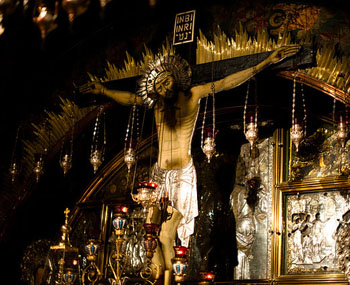
Let us continue to be astonished at the beauty of the Liturgy. To preside at the Eucharist is to be plunged into the furnace of God’s love. — Pope Francis
[Re-post from 2022 in honor of Holy Thursday]
What makes the Liturgy, and above all, the Mass, beautiful? Christ. He is beautiful, is Beauty itself. Liturgy unveils the beauty of Christ’s redeeming death and resurrection, manifesting every facet of the divine love. “Having loved his own who were in the world, he loved them to the end” (John 13:1). These words that introduce the Last Supper discourse in John’s Gospel are the true splendor of all Liturgy.
Yes, liturgical beauty is enhanced by art and architecture, music and vestments, incense and bells, language and ritual gesture. Thank God for these sacramentals! However, liturgical beauty is made by love alone. This is why the sign of truly great liturgy is an increase in kindness, patience, gentleness, generosity, mercy and forgiveness among those who participate. To be devoted to liturgy and not to be converted toward a more authentic Christlike love is, simply said, dangerous. Better to not worship at all.
As the Prophet Amos voiced God saying to Israel:
I hate, I despise your festivals,
and I take no delight in your solemn assemblies.
Even though you offer me your burnt offerings and grain offerings,
I will not accept them,
and the offerings of well-being of your fatted animals
I will not look upon.
Take away from me the noise of your songs;
I will not listen to the melody of your harps.
But let justice roll down like water
and righteousness like an ever-flowing stream.
Back in 1991, I had the privilege of spending part of my summer with a retired parish priest, Fr Albert Goulet. He was in a nursing home at the time, a truly extraordinary man who faithfully lived his priesthood for over sixty years.
Fr. Goulet invited me that summer to join him every morning at 5:30 a.m. in his room for Mass. He celebrated it on his folding TV dinner table draped with a white cloth, using his tiny travel-sized sacred vessels. Because he had had a minor stroke a few years before that left him partly paralyzed, he would struggle through the words of the Mass, slurring and drooling as he spoke. He invited me each morning to sing some opening hymn, always totally off key. When he elevated the Host, and then the Chalice, after the words of consecration he would whisper with such deep feeling: “My Lord and my God.” Lovelier than any Palestrina I had ever heard.
I remember especially vividly, on Trinity Sunday, when he preached to me on his own love for the Father, the Son and the Holy Spirit. He stopped partway through his homily to awkwardly cry for a moment. I think the Angels hid their faces. I wrote this later that evening:
It’s hard to look at him in the eye sometimes. His body is covered by clothes damp with drool, he slouches toward death. His hand shakes. His voice gurgles. But when he speaks, you can feel that body enshrines a spirit afire with life. It’s impossible. His sagging flesh is like soft clay, supple, reworked over and over in the Potter’s hands. Yes, he’s hunched, curved in on himself in body. But he’s upright in soul. He said today, ‘Tom, our body is a temple of the Trinity.’ This old man has shrunken down into a child, tiny enough to enter a Kingdom. So small it cannot be seen except by little children. He is. He is a priest who has become the sacrifice. It all shakes me.
I cannot say this forcefully enough: those Masses still are — without peer — the most beautiful, transcendent and sacred liturgies I have ever participated in in my life. They led me deeper into the mystery of a divine and human love, wrapped in this priest’s purity of heart, his weakness and irrelevance in a world that worships Utility. Another time I wrote in my journal:
These mornings, I’ve felt so near to the one and only true Mass
on Golgotha, celebrated by a High Priest
robed only in flies
his naked Flesh anointed in sweat and blood
who could only speak slurred words
of both Offering and of Blessing
amid His gasps for breath
reeking stench
of the sweetest incense
arising from a love beyond all telling.
More sacred for its proximity to Calvary.
Anytime I hear liturgy spoken of with a lack of love, used as a weapon of division, derision, disobedience or contempt — I see a lovelessness knowing nothing of Christ. I see sacrilege, idolatry, the worship of worship. St. John Chrysostom’s words come to mind:
Consider that Christ is that tramp who comes in need of a night’s lodging.
You turn him away and then start laying out rugs on the floor,
draping the walls, hanging lamps on silver chains on the columns.
Meanwhile the tramp is locked up in prison and you never give him a glance.
Well again, I am not condemning lavish generosity in these matters.
Make God’s house beautiful by all means
but also look after the poor,
or rather look after the poor first.
No one was ever condemned for not adorning his house,
but those who neglect the poor
were threatened with hellfire for all eternity
and a life of torment with devils.
Adorn your house if you will,
but do not forget your brother in distress.
He is a temple of infinitely greater value.
Beautiful, Tom! Thank you
Excellent reflecting on this for the Triduum.